
-
Find the right food for your petTake this quiz to see which food may be the best for your furry friend.Find the right food for your petTake this quiz to see which food may be the best for your furry friend.Featured products
 Puppy Food
Puppy FoodHill's Science Plan Puppy Multipack Wet Dog Food with Chicken & Beef are complete premium pet foods for growing puppies from weaning until 1 year old and for pregnant and nursing dogs. Your puppy will love these deliciously smooth and savoury minced loaves, formulated for balanced nutrition and overall health.
Shop Now Adult Wet Dog Food with Beef
Adult Wet Dog Food with BeefHill's Science Plan Adult Multipack Wet Dog Food with Chicken, Beef & Turkey are complete premium pet foods for adult dogs from 1 year. Your dog will love these deliciously smooth and savoury minced loaves, formulated for balanced nutrition and overall health.
Shop Now Mature Adult Dog Food
Mature Adult Dog FoodHill's Science Plan Mature Adult Multipack Wet Dog Food with Chicken & Beef are complete premium pet foods for mature adult dogs from 7 years. Your dog will love these deliciously smooth and savoury minced loaves, formulated to deliver the appropriate amount of energy to support the needs of adult dogs.
Shop NowFeatured products Light Adult Multipack Wet Cat Food with Chicken & Ocean Fish
Light Adult Multipack Wet Cat Food with Chicken & Ocean FishTender chicken chunks in gravy for cats, with L-carnitine and fewer calories for ideal weight management. Packed with high-quality protein, omega-6s, and vitamin E for shiny fur and healthy skin.
Shop Now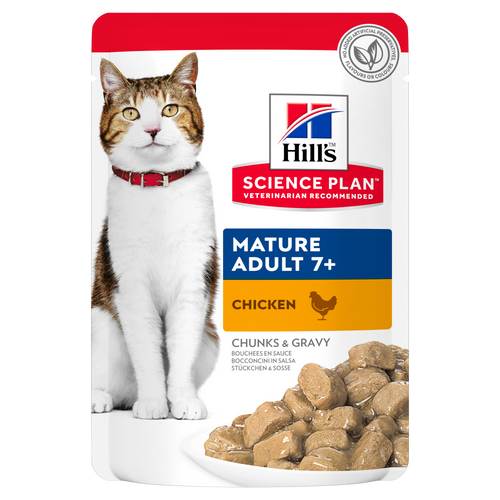 Mature Adult Wet Cat Food with Chicken
Mature Adult Wet Cat Food with Chicken
Tender chicken chunks in gravy for mature adult cats. Made with easy-to-digest ingredients, high-quality protein for lean muscle maintenance and antioxidant vitamins C+E for optimal health.
Shop Now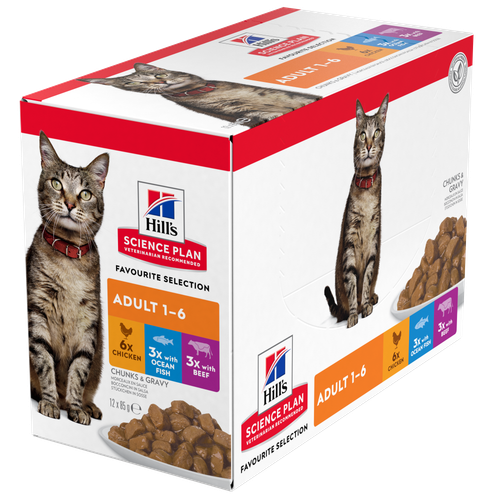 Adult Multipack Wet Cat Food with Beef, Ocean Fish & Chicken
Adult Multipack Wet Cat Food with Beef, Ocean Fish & ChickenTender chunks in gravy for cats, with high-quality protein to maintain lean muscle. With vitamin E and omega-3s & -6s for healthy skin and balanced minerals to support healthy vital organs.
Shop Now -
Dog
- Dog Tips & Articles
-
Health Category
- Weight
- Food & Environmental Sensitivities
- Urinary
- Digestive
- Joint
- Kidney
-
Life Stage
- Puppy Nutrition
- Adult Nutrition
- Senior Nutrition
Cat- Cat Tips & Articles
-
Health Category
- Weight
- Skin & Food Sensitivities
- Urinary
- Digestive
- Kidney
-
Life Stage
- Kitten Nutrition
- Adult Nutrition
Featured articles The Incredible Science Behind Your Pet's Microbiome
The Incredible Science Behind Your Pet's MicrobiomeLearn what your pet's microbiome is, how it contributes to your pet's gut and overall health, and why nutrition is important in maintaining healthy microbiomes.
Read More Show some love with wet foods: a great choice for pets with health issues
Show some love with wet foods: a great choice for pets with health issuesShow some love with wet foods: a great choice for pets with health issues.
Read More The Right Diet For Your Pet
The Right Diet For Your PetIn people, the right diet is very important. If you are eating the wrong way for your metabolism, activity level, age and lifestyle you could end up with health issues.
Read More -


Cats can get allergies, just like humans, but cats are also masters of hiding medical issues from their pet parents, so early signs can easily go unnoticed. Understanding the different types of allergies cats can get is an important part of being able to spot them early on. The earlier you can find out what the problem is, the sooner treatment can be started and your cat can find some welcome relief.
Allergies in cats are commonly separated into three categories: flea, environmental and food. But of course, it isn’t quite as simple as it might seem. Just the same as us, some cats can have multiple allergies affecting different systems in the body. In this article we’ll look at the types of allergies, their clinical signs, how they are diagnosed and treatment options.
Clinical Signs of Allergies in Cats
The clinical signs of allergies in cats can vary hugely, depending on what is causing the allergy. For example, an allergy to a pollen may cause the respiratory signs of feline asthma, while a flea allergy will cause intense itching. The three main systems affected are the skin, the digestive tract and the respiratory tract. Let’s have a look at them one at a time.
Skin signs in allergic cats
Allergies of different kinds can cause skin-related symptoms, including severe itching. You may notice your cat scratching more than usual, but cats can be quite different to dogs when it comes to itchiness. Very often, itchy cats will groom excessively, using licking as the main means of soothing the itch. You may also see chewing of the fur and skin or rubbing their face and bodies more than usual on doorposts and furniture. Many times, the itchiness will result in visible areas of skin irritation and the pet parent may see the following:

Fur loss
Redness
Skin rash
Scabs
Any signs of skin irritation
Gastrointestinal signs in allergic cats
These signs are most often caused by adverse food reactions, including food allergies. As you might imagine, the main gastrointestinal symptoms in allergic cats are vomiting and diarrhoea. However, as we said, cats are good at keeping to themselves and prefer to go outside to go to the toilet. So unless your cat is using a litter tray or is so affected that they lose control in the house, you might not notice these signs at all. With this in mind, you’ll see why sometimes the first sign of a GI upset due to an allergy is unexplained weight loss even though your cat might be eating well. If your cat has abdominal pain due to a food allergy, they may well go off their food.
Summary of GI symptoms:
Diarrhoea
Vomiting
Weight loss
Loss of appetite
Flatulence or excessive wind
Respiratory signs in allergic cats
Common allergens that cause respiratory symptoms are secondhand smoke, pollen, chemicals, mould, dust mites and more. Common signs you may see are:
Coughing
Wheezing
Sneezing
Runny eyes or nose
Open-mouth breathing
Breathlessness and collapse in severe cases


Tasty Tips
Common causes of allergies in cats
The most common types of allergies that affect cats include:
1. Flea Allergies
Getting fleas is a fact of life for cats. Even if your cat is an indoor cat, you can track fleas in on clothing, as can visiting animals. Most animals never have an issue if they have fleas, but some cats become allergic to flea bites and this is a different matter.
An allergy to fleas is one of the most common skin conditions seen in cats. Flea allergies are caused by a reaction to the saliva transferred by a flea's bite. Many times, the fleas may not be seen by the pet parent or even the vet during a physical examination. It can take only a few bites to incite the intense itchiness associated with a flea allergy. Clinical signs may include itchiness, hair loss, skin redness and scabs, which are most common on the head, neck and lower back or tail. This intense reaction to just the occasional bite makes flea allergies more difficult to manage than fleas affecting a non-sensitive cat.
2. Environmental Allergies - Atopy and Contact Dermatitis
Cats can also have allergic reactions to things in their environment, just like humans. These include atopy and contact dermatitis. Atopy, or atopic dermatitis, is a reaction to environmental allergens such as trees, grass, mould and dust mites. Due to allergies to plants, atopic cats may have very marked seasonal flare-ups, like humans with hayfever. On the other hand, dust mites and moulds may be a year-round problem.
Contact dermatitis is an allergic reaction to something the cat actually touches, like plastics used in food and water bowls, cleaning products and detergents.
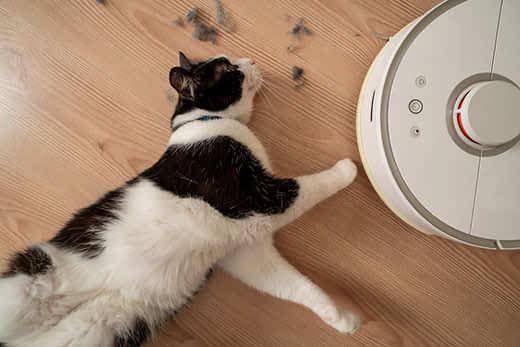
3. Food Allergies
As opposed to the seasonal flares seen in some atopic cats, in cats with food allergies, the main skin symptom is constant, non-seasonal itchiness. In addition, some cats with food allergies may also have gastrointestinal issues such as vomiting, diarrhoea, weight loss and decreased appetite. And just to make things more complicated, some cats might only have gut symptoms and no skin symptoms!
Cats can be allergic to any foods, but the most common culprits are chicken, beef, fish and dairy products. Allergic reactions to food are virtually always to the proteins in the food.
How are cat allergies diagnosed?
Getting to the bottom of allergies can be lengthy and costly, so be prepared. In the case of skin signs, there are lots of other things besides allergies that can be the problem, and your vet will need to consider those too. It’s a case of systematically ruling things in or out. It’s also important to remember that your cat might be allergic to several things at once.
Flea allergy: This is often one of the easier allergies to diagnose. The distribution of hair loss and scabs is very typical, and your vet will also look for flea dirt. This is flea faeces and is essentially digested blood. Fleas spend most of their time in the soft furnishings of your house and not on your cat, so you may never see them unless you have a bad infestation. But looking for flea dirt is easy to do at home. You just need a fine-toothed comb and a piece of white kitchen roll. Comb through your cat’s fur onto the tissue. If you see black flecks, moisten them with water. If it’s just dirt from rolling around in the garden, nothing will happen; if it’s flea dirt, the paper will turn red.
Environmental allergies: Most cases of atopy can be diagnosed through skin tests or, more commonly nowadays, blood tests. Skin tests involve clipping a patch of fur from the side of your cat and injecting tiny amounts of different allergens in a grid shape. After 15-30 minutes, swollen, red dots will appear around anything your cat is allergic to. This is very accurate. Blood tests are easier but not quite as reliable.
Contact allergies will be ruled in or out by changing bowls for ceramic ones and using different detergents for a period of time.Food allergies: The easiest way to diagnose or rule out a food allergy is with a so-called food elimination trial. This involves feeding your cat a food that is either novel or hydrolysed. A novel diet is one that only has protein and carbohydrate sources that they’ve never eaten before and therefore can’t be allergic to. This can be difficult because over the years a lot of cats are given lots of different foods and may also be eating elsewhere. A hydrolysed diet is one where the proteins have been broken into tiny pieces that are too small for the body's immune system to recognise. In theory, hydrolysed diets can be fed to any animal with any adverse food reaction.
For skin symptoms, your cat must be fed an elimination diet for at least 12 weeks. Gut signs usually resolve much faster, within 2-4 weeks. It’s essential while your cat is on one of these trials that you feed it nothing else.
At the end of the trial, if symptoms have resolved, you may decide to just continue with that food. Some pet parents want to change things up, so you can try adding in products one by one to see if they cause a flare-up. For example, a little bit of cooked chicken on top of the therapeutic diet for a week or two. Your vet will be able to guide you.
As we said before, there are lots of other things that can cause skin signs, and occasionally these can look very similar to an allergy. Be patient with your vet while they do their investigations. A methodical approach will be better in the long term.
Environmental allergies: Most cases of atopy can be diagnosed through skin tests or, more commonly nowadays, blood tests. Skin tests involve clipping a patch of fur from the side of your cat and injecting tiny amounts of different allergens in a grid shape. After 15-30 minutes, swollen, red dots will appear around anything your cat is allergic to. This is very accurate. Blood tests are easier but not quite as reliable.
How are cat allergies treated?
In the early stages, your vet might provide treatment to make your symptomatic cat more comfortable and reduce the itchiness. They might also need antibiotics if they have self-traumatised and bacteria from the skin have penetrated and caused a secondary infection.
In the longer term, once your cat has been diagnosed, the main types of treatments and therapies are:
Medication. This could be:
To break the itch-scratch cycle. These medications would include things like steroids and antihistamines.
To reduce the allergic reaction. These are drugs that work on your cat’s immune system to reduce the overreaction to the allergen.
Preventative. For cats with flea allergies, preventative medication is essential. Your vet will advise you on what products to use and how often. Sticking to this schedule – and treating your home as well – is paramount for success.
Topical. Your vet may want to use shampoos or topical medications to eliminate allergens or provide relief.
Eliminating allergens. The best way to treat environmental allergies is to remove the trigger allergen from the environment. Using air purifying machines, vacuuming frequently, and washing your cat’s bedding and other household items that can trap allergens help reduce environmental allergens. Using metal bowls and washing them frequently and using unscented cleaning products, detergents and litters can also be helpful.
Immunotherapy. This is a tailor-made desensitisation program for your cat’s specific allergies. After skin or blood tests, your vet can order this for you. It involves injecting increasing amounts of allergens at various intervals. These start off almost imperceptible and very gradually increase, usually over about a year, until your cat no longer reacts. It’s not a guaranteed cure, but it can make a huge difference to lots of animals.
Diet. As we said, after an elimination trial, you may need to feed your cat a specific therapeutic diet to avoid food allergens. Or you may find you can buy various foods and just avoid certain ingredients. For cats with atopy, having a special diet can still be beneficial. Lots of diets for skin conditions have high levels of omega fatty acids. These can have an anti-inflammatory effect but also help skin function. Now that you've learned that cats can indeed have allergies, you know to be on the lookout for excessive itching and skin irritation or gastrointestinal upset. There are many options for treatment based on the underlying cause of the allergy, including oral and topical medications as well as special foods. With a treatment plan put in place by you and your veterinarian, many cats with allergies are able to lead a happy and full life.
FAQs
What are the first signs of allergies in cats?
The first signs of allergies in cats often include excessive grooming, scratching and chewing of their fur and skin. You may also notice skin irritation, redness, scabs or hair loss. Gastrointestinal issues such as vomiting or diarrhoea can also be signs, especially with food allergies.Can indoor cats develop allergies?
Yes. Cats can be allergic to lots of household substances, foods and airborne things like pollen. Fleas can also be brought into the house on clothing, so indoor cats can also have flea allergies.What’s the best food for cats with allergies?
That will depend on the allergy. For food allergies, your cat might need a hydrolysed diet. Some therapeutic diets help overall skin health for atopic cats. Speak to your vet about the best solution for your individual cat.Can you blood test for food allergies?
There are blood tests available for food allergies, but they are, at this time, not reliable. Your money is better spent on an elimination trial.


Jessica Seid is an emergency veterinarian practicing in the New England area. She is a graduate of the North Carolina State College of Veterinary Medicine and has been in the field for more than a decade. When she's not helping patients, she enjoys spending time with her husband, daughter and French bulldog.
Related products

Tender chicken chunks in gravy for cats, with L-carnitine and fewer calories for ideal weight management. Packed with high-quality protein, omega-6s, and vitamin E for shiny fur and healthy skin.

Tender chicken chunks in gravy for mature adult cats. Made with easy-to-digest ingredients, high-quality protein for lean muscle maintenance and antioxidant vitamins C+E for optimal health.

Tender chunks in gravy for cats, with high-quality protein to maintain lean muscle. With vitamin E and omega-3s & -6s for healthy skin and balanced minerals to support healthy vital organs.

Related articles

There are three common ways to feed a cat. Each way has its advantages and disadvantages.

From essential vitamins & minerals to different types of meat, learn what to look for when choosing the best cat food for your feline.
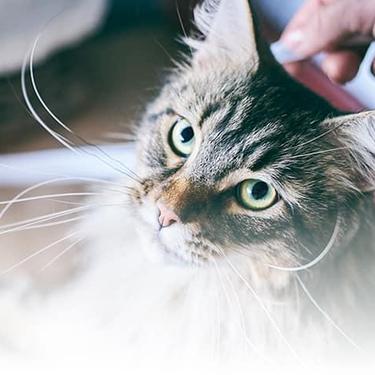
Learn how to make homemade cat treats that are healthy for your pet with this recipe from Hills Pet Nutrition.
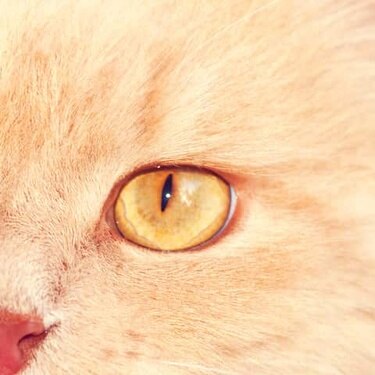
Chocolate is known to be poisonous for dogs, but it can also be toxic for cats. Learn why chocolate is bad for cats & what to do if she's eaten it.
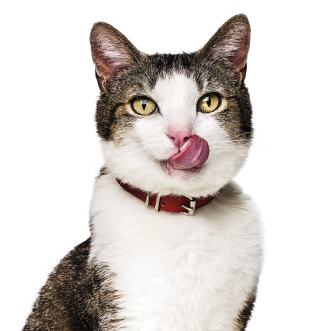
Put your cat on a diet without them knowing
Our low calorie formula helps you control your cat's weight. It's packed with high-quality protein for building lean muscles, and made with purposeful ingredients for a flavourful, nutritious meal. Clinically proven antioxidants, Vitamin C+E, help promote a healthy immune system.
Put your cat on a diet without them knowing
Our low calorie formula helps you control your cat's weight. It's packed with high-quality protein for building lean muscles, and made with purposeful ingredients for a flavourful, nutritious meal. Clinically proven antioxidants, Vitamin C+E, help promote a healthy immune system.

